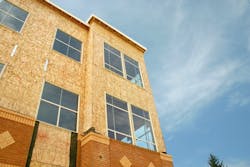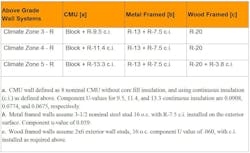Which Is More Efficient: Wood Walls or Steel and Masonry With Continuous Insulation?
It is widely known that wood offers higher levels of thermal resistivity versus other framing materials. In fact, wood naturally has nearly four times the thermal resistance of steel or masonry. The 2015 International Energy Conservation Code (IECC) recognizes this difference and requires continuous insulation on steel and concrete masonry unit (CMU) wall assemblies.
Some building pros assume that the use of steel and concrete masonry wall systems with continuous insulation (c.i.) provides a wall superior in energy efficiency to wood-framed construction without continuous insulation. This assumption is based on a misconception that continuous insulation mitigates the insulating deficiencies of steel framing and CMU walls by neutralizing the significant thermal bridging in non-wood structures.
APA put this assumption to the test with an energy-efficiency analysis that compared steel framing and masonry block wall assemblies that use continuous insulation with wood-framed wall construction without continuous insulation.
The Analysis
The purpose of this analysis is to determine the impact of three wall assembly types on the annual cost of energy consumption in the three different climate zones. Table 1 shows the three systems based on Group R occupancies for multifamily buildings in climate zones 3, 4, and 5. Three types of wall construction systems were selected from Table C402.1.3 of the 2015 IECC, and each system was evaluated for each climate zone. The design parameters are identical except for the type of wall system. The evaluation was done using RemDesign software, a nationally recognized tool for calculating the energy consumption of residential building designs, and is based on a 28,500-square-foot multifamily building with 256,500 cubic feet of volume consisting of 27 individual units with 57 bedrooms. For more technical details on the analysis, see www.apawood.org/designerscircle-energy-efficient-walls.
In climate zone 3, the annual cost for energy consumption of the buildings with the wood-framed walls was $1,317.24. The cost of energy for the steel-framed and the CMU walls was $1,308.03 and $1,307.40, respectively. The results indicate that the wall systems, as listed in the IECC, have similar levels of performance in terms of energy efficiency in relatively warmer climates.
In climate zone 4, the wood-framed, steel-framed, and CMU walls result in an annual energy consumption cost of $1,030.14, $1,019.70, and $980.33, respectively. In this climate zone, wood-framed walls and steel-framed walls utilize almost the same amount of energy, while CMU walls with a thicker c.i. requirement perform slightly better.
In climate zone 5, the annual energy consumption costs are $831.18, $978.65, and $912.65 for wood, steel, and CMU, respectively. In this climate zone, the wood-framed walls are required to have continuous insulation with a minimum R-value of 3.8 installed on the exterior. As a result, the wood framed walls reduce annual energy consumption by 18 percent compared to steel framing and by 10 percent compared to CMU walls. The benefits of using wood-framed wall assemblies become more apparent in increasingly colder climates.
In evaluating the energy savings between a standard R-20 wall system and the R-20+3.8 c.i., the difference was only 0.06 percent, or roughly $8, a month in climate zone 5. This also assumes that the R-20+3.8 c.i. assembly has wood structural panel sheathing installed under the foam sheathing for structural design. The analysis also evaluated the annual energy consumption cost in climate zone 5 of an R-20 wall without the R-3.8 continuous insulation as compared to steel and block wall assemblies. The annual energy consumption costs are $960.34, $978.65, and $912.65 for wood, steel, and block, respectively. Even without the R-3.8 continuous insulation, the wood wall surpasses the efficiency of the steel wall framing with continuous insulation.
Building designers frequently influence the type of exterior wall construction used in buildings. In determining the construction type to be used, designers need to take into account the many exterior wall performance requirements that will result in code-compliant, durable, comfortable, and cost-effective buildings. As the most recent energy codes are adopted by jurisdictions, finding a balance between energy efficiency, structural needs, and construction costs is even more important. The natural insulating characteristics of wood framing and wood structural panel wall sheathing lead to better thermal performance when compared to steel and block. Continuous insulation increases thermal resistance to all wall systems, but as demonstrated in these evaluations, using continuous insulation over steel framing and block assemblies doesn’t always produce an equivalent level of performance to wood-framed systems. On your next project, consider that sustainable wood framing is not only more cost effective to build, but can also be more energy efficient.
For more resources on wood in commercial design, including technical articles and case studies, become a member of APA Designers Circle at www.apawood.org/designerscircle. A free online community for architects, engineers, and other members of the commercial building industry, Designers Circle provides timely information, technical resources, continuing education, and recommendations for innovative wood-frame construction.


